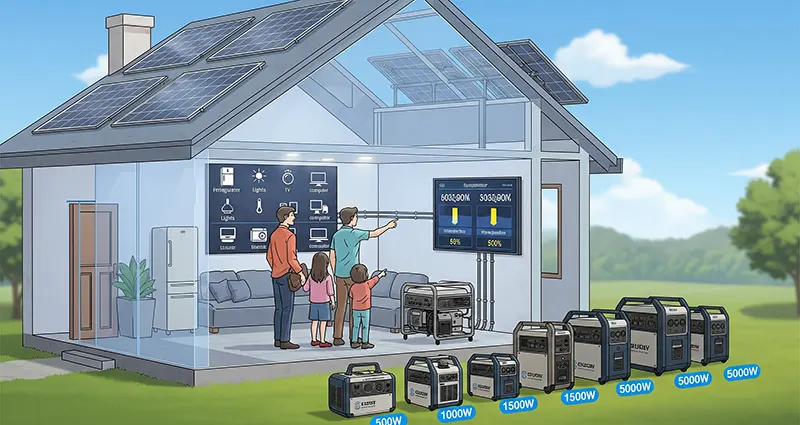Power outages can disrupt daily life and compromise safety, especially during emergencies. A solar generator offers a clean, renewable, and reliable backup power solution for your home. But to maximize its benefits, it’s essential to select the appropriate size. In this article, we’ll explore how to choose the right size solar generator for home backup to ensure your energy needs are met efficiently and effectively.
Why Size Matters in a Solar Generator
The size of a solar generator refers to its energy storage capacity (measured in watt-hours, Wh) and power output (measured in watts, W). Choosing the correct size guarantees that your solar generator can power essential appliances when you need it most without overspending on unnecessary capacity.
Steps to Choose the Right Size Solar Generator for Home Backup
1. Assess Your Power Needs
Determine which appliances and devices you want to power during an outage. Common essentials include:
- Refrigerator (typically 100-800W)
- Lights (5-20W per bulb with LEDs)
- Smartphone and laptop chargers (5-100W)
- Medical devices (varies widely)
- Fans or small heaters (150-1500W)
- Wi-Fi router (5-20W)
Make a list and note the wattage of each device, which can usually be found on the appliance label.
2. Calculate Total Power Consumption
Add up the wattage of all appliances you plan to run simultaneously. This gives you the required continuous power output in watts. For example, running a 100W fridge and 40W of lighting together requires at least 140W continuous output.
3. Estimate Energy Usage Over Time
Solar generators store energy in watt-hours (Wh), representing how much energy the battery can deliver over time.
- Multiply the wattage of each device by the number of hours you expect to run it per day.
- Sum these to find your total daily watt-hour consumption.
For example:
| Device | Watts | Hours per Day | Total Wh (Watts x Hours) |
| Refrigerator | 150 | 24 | 3600 |
| LED Lighting | 20 | 5 | 100 |
| Laptop Charger | 60 | 4 | 240 |
| Smartphone Charger | 10 | 4 | 40 |
| Total | 3980 Wh |
4. Choose Battery Capacity with Margin
Select a solar generator with a battery capacity greater than your total daily consumption to account for inefficiencies, cloudy days, or additional power needs. Adding a 20-30% safety margin is a good practice.
5. Check the Power Output Rating
- Ensure the generator’s inverter can handle the peak load, i.e., the highest power demand when multiple devices start simultaneously.
- Look for surge capacity (usually higher than continuous power) to handle appliance start-up surges like refrigerators or pumps.
6. Consider Solar Panel Size and Charging Rate
A solar generator recharges via solar panels or AC power. To fully recharge daily:
- Choose solar panels with adequate wattage to replenish the battery based on your usage and sun availability.
- For example, if your daily consumption is 4000 Wh, a 400W solar panel array under good sunlight might require about 5-6 hours to recharge.
7. Evaluate Portability vs. Capacity
If your backup power needs are stationary and extensive, a larger, heavier solar generator is suitable. For occasional or portable use, consider smaller units with sufficient power but easier transportation.
Additional Tips
- Check Expandability: Some solar generators allow battery expansion for future increased capacity.
- Look for Pure Sine Wave Inverters: These protect sensitive electronics.
- Read Customer Reviews: Real-world feedback can provide insight into performance and reliability.
Understanding how to choose the right size solar generator for home backup enables you to prepare effectively for power outages while optimizing cost and functionality. By carefully assessing your power needs, calculating consumption, and selecting a generator with adequate capacity and output, you can provide your household with reliable, clean energy when it matters most. Investing time in sizing your solar generator correctly ensures peace of mind and a resilient home energy system.












